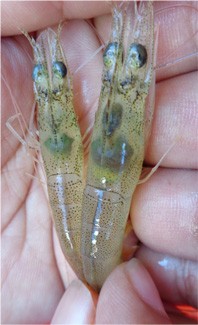A team of UA researchers recently discovered what has been causing large amounts of shrimp in Asia to die and has led to a global shortage.
A harmful new strand of bacteria — which evolved from a common strand of bacteria that the shrimp were already exposed to — is causing a disease called Early Mortality Syndrome. The disease has seriously affected shrimp hatcheries in Asia and is continuing to spread, causing a worldwide shrimp shortage.
Early Mortality Syndrome occurs within a few days of taking the larval shrimp from the hatcheries to ponds, where they are supposed grow for about 120 to 140 days. However, when shrimp have the bacterial infection, they start dying within a week or two of going into the ponds, said Kevin Fitzsimmons, researcher and director for the College of Agriculture and Life Sciences’ International Programs.
The disease originated in China, causing the country’s shrimp industry to be the first one affected by an outbreak, in 2010. It then spread to Vietnam in 2011 and Thailand and Malaysia in 2012, and has begun to spread globally. It was traced to Mexico and India this year, Fitzsimmons said.
“Thailand and Vietnam’s production of shrimp has dropped more than half, devastating the industry,” Fitzsimmons said.
The UA began researching the shrimp shortage about two-and-a-half years ago, after lead researcher Donald Lightner, professor of animal and comparative biomedical sciences, identified the bacteria, though he did not yet know the cause, Fitzsimmons said. The research team is currently in Vietnam, sharing its findings on the disease and meeting with farmers, hatchery managers, government representatives and scientists.
“We will go over how to identify the disease, do the diagnostics, how to manage it and how the farms in the industry can get over this problem,” Fitzsimmons said.
The global shrimp shortage has even affected local Tucson seafood restaurant Mariscos Chihuahua. Delia Preciado and her husband, who own one of the locations in town, said about half of their seafood dishes include shrimp. Preciado said she has seen the price of shrimp increase substantially in recent years. In 2010, the restaurant was paying about $4 per pound of shrimp, and now it is paying about $7 per pound, she added.
“With steady business and clientele, we haven’t directly been harshly affected, economically,” Preciado said. “But if the prices continue to increase, then that may change.”
Shane Burgess, dean of the College of Agriculture and Life Sciences, said the UA’s discovery is central to the sustainability of the shrimp industry.
“The U of A has been on the map for our work in shrimp disease for a long time,” Burgess said. “This really is a big deal for the world — that we don’t have this industry collapse.”
– Follow Adriana Espinosa @adri_eee









